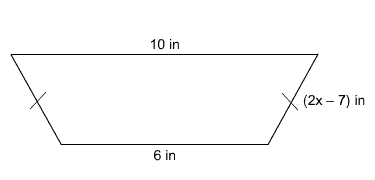Perimeter of Trapezoids and Kites
As you know from earlier lessons, the perimeter of a figure is the sum of the lengths of all of the sides of the figure. Trapezoids and kites are the same.
To find the perimeter of a trapezoid, add base 1 plus base 2 plus leg 1 plus leg 2.
|
Trapezoids: P = b1 + b2 + l1 + l2, where b1 and b2 are the lengths of the bases and l1 and l2 are the lengths of the legs. |
To find the perimeter of an isosceles trapezoid, add base 1 plus base 2 plus two times leg 1.
|
Isosceles Trapezoids: P = b1 + b2 + 2l1, where b1 and b2 are the lengths of the bases and l1 is the length of both legs. Since the legs are congruent, we can just multiply the length by two. |
Example:
The perimeter of this isosceles trapezoid is 54 inches. Find the value of x.

Because this is an isosceles trapezoid, we know that the other leg also has a measure of (2x – 7) inches.
10 + 6 + 2(2x – 7) = 54
10 + 6 + 4x – 14 = 54
4x + 2 = 54
4x = 52
x = 13
To find the perimeter of a kite, add 2 times one side length plus two times the other side length.
|
Kites: P = 2s1 + 2s2, where s1 is the length of one pair of congruent sides and s2 is the length of the other pair of congruent sides. |
We will look at an example of finding the perimeter of a kite together in a few pages.